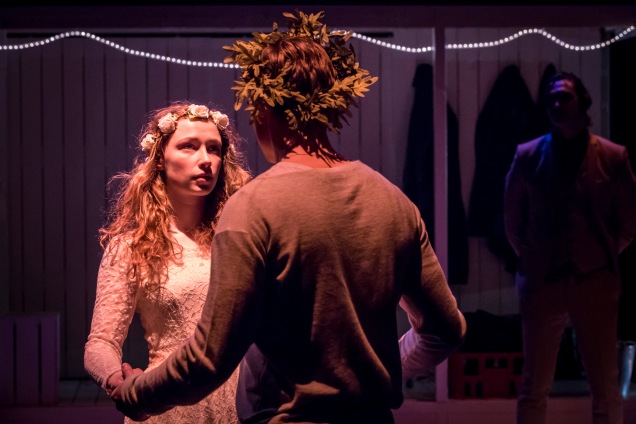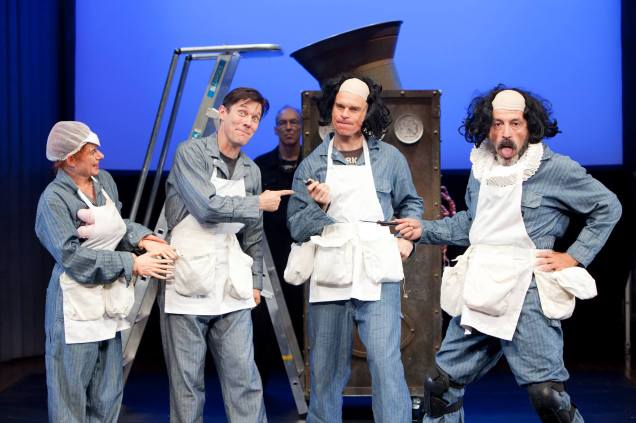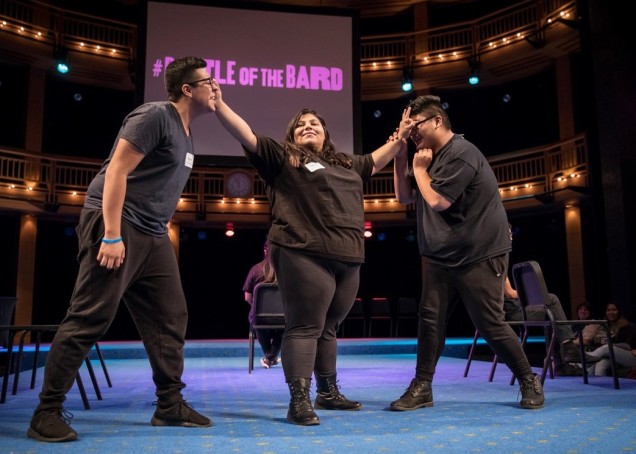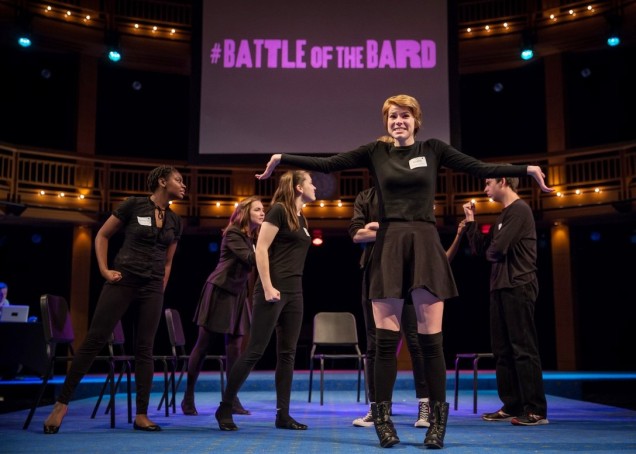Recently, Berwyn’s Autre Monde Café & Spirits played host to 16th Street Theater’s performances of three sketches inspired by William Shakespeare’s The Two Gentlemen of Verona as part of Shakespeare 400 Chicago’s Culinary Complete Works series. Providing delectable fare for both the mind and body, this event held on November 16 provided a new way of transporting the body through taste into a different time period and culture while exploring how controversial Shakespearean themes and conventional devices can be updated and revised to provoke self-reflection in a twenty-first-century context. Sending their dinner guests on a gastronomical excursion from Verona to Milan, Chefs Dan Pancake and Beth Partridge of Autre Monde served up a delicious gourmet meal following champagne and hors d’oeuvres, concluding with dessert and coffee. Welcoming guests to the Berwyn community to “see what we do,” Sommelier John Aranza provided regional wine pairings to complement each course, explaining that his choices were inspired by the culture and history of northern Verona. Between each serving, dinner guests were transformed into members of a theater audience as actors performed scenes composed by playwrights Rob Koon, Arlene Malinowski and Juan Villa, inspired by the work, but not written in the original language of Shakespeare.
Following applause, the first course was immediately served, consisting of Poached Lake Trout, Pesto Prezzemolo, a delicious dish which had a sour, herbal sauce lavished on the meat accompanied by warm, well-cooked purple cauliflower. This was paired with Ca’ Di Rajo’s Le Moss from Trentino, made with unfiltered Glera grapes, which was described to me by the sommelier as “fresh and harmonious, with an exotic muskiness.” Taste-wise, this sparkling white wine possessed a tart, earthy tang, with a bouquet like an apple orchard in harvest. Experienced simultaneously, such a counterintuitive taste and smell agreeably confused the palate.
After the first course, two actors played the roles of Shelly and David in “Coffeehouse” by Robert Koon in a scene based loosely on Proteus’s deceitful love for Valentine’s fiancée in Two Gentlemen. Likely written and performed between 1590 and 1593, this play is an early comedy, possibly representing Shakespeare’s initial, or at least first successful, foray as a playwright. In a hilarious subplot that delighted Queen Elizabeth, Sir Proteus’s bumbling Lance, prone to spouting malapropisms and acting out tearful family partings with old shoes, carries on a fraught, but devoted relationship with his misbehaving dog, Crab. Despite hinting at Shakespeare’s budding comedic genius, this comedy contains near tragedy, its main plot depicting how a devoted friendship between two men, Proteus and Valentine, flounders in jealousy and betrayal due to mutual passion for the same woman, the fair Silvia. After pretending to promote his friend’s suit, Proteus lays siege to Silvia’s heart and, proving unsuccessful in his endeavor, threatens her with rape:
PROTEUS Nay, if the gentle spirit of moving words
Can in no way change you to a milder form
I’ll woo you like a soldier, at arm’s end,
And love you ‘gainst the nature of love: force ye.
SILVIA O heaven!
PROTEUS (assailing her) I’ll force thee yield to my desire.
(5.4. 55-59)
After rescuing Sylvia from Proteus’s onslaught, Valentine appears to offer his fiancée to him for the sake of preserving their comradeship in a scene that has long puzzled Shakespearean critics and embarrassed directors keen for an alternative. All is resolved, however, with Valentine and Silvia reunited and repentant Proteus returning to his longsuffering love Julia, who has followed him disguised in male attire.
Though “Coffeehouse” eloquently speaks to the conflict between succumbing to the temptations of mimetic desire and conforming to standard morality in the name of friendship, the piece largely sidesteps the original play’s issues with rape, sexual consent, and the commodification of women. Of course, such delicacy may be due to the undeniable fact that such repellent scenes might put diners off their food, exemplified by the shocking lack of Thomas Middleton and John Webster-themed dinner theater. Meeting for drinks tête à tête, DAVID ponders aloud to SHELLY, his best friend JOHN’S girlfriend and his not-so-secret crush, “…Sometimes I wonder what it would be like not to be a good friend. Sometimes I wonder what it would be like to be an asshole…Not making a choice, it’s just easier. Doesn’t mean you’re not an asshole, you’re just an internal asshole.” After being reassured by an anxious SHELLY that he is “…not an asshole. Not even an internal one,” David gives the following response, a mightily ambiguous one, considering the original character Proteus’s justification of rape as a mechanism for physically overcoming female disinterest and rejection:
Oh, I could be. All it takes is justification. And you can justify anything. I could justify all sorts of things. It’s easy. You just say something’s really important to have, say, love, and then all you have to do is say, hey, if love’s the most important thing, you have to go after what you love. And anything that stands in your way, well, it’s not as important as love, so it’s got to go. You can justify anything.
Clearly, ignoring female autonomy is not at issue here in Koon’s scene so much as the question of potential heterosexual betrayal, contingent on violating masculine trust. Being an “asshole” does not equate to threatening rape, nor does “love” serve as a substitute for sexual assault. But David’s use of phrases such as “You have to go after what you love” and belief that “You can justify anything” if it stands in the way of love, indicates the moral fragility of David’s character and recalls Proteus’s willingness to overcome Sylvia if he cannot win her verbal acceptance of his suit. However, differences do exist between Shakespeare’s Sylvia and SHELLY, who, while also reminding DAVID of his prior romantic interest JULIE (Julia) seems physically responsive to DAVID, holding his hand and lingering when she should leave. These changes effectively downplay the Sylvia character’s disinterest, call her own motivations into question in meeting up sans boyfriend in the first place, and suggest that the themes of faithfulness and betrayal, not the threat of sexual violence, occupy the focus of Koon’s contemporary scene.
The second course was Tortallacci Bergamese, made with brown butter, sage, and parmigiano, paired with a refreshingly crisp and sharp Freccioarossa “Sillery” Pinot Nero Bianco, from Lombardia (2015). The main dish, my favorite of the evening, had a sweet nut garnish with a savory veal pasty, amoretti, pinenuts and raisins. Judging from the taste I thought hazelnut or almond liquor might have been mixed into the sauce. Apparently, if a Pinot Noir is denied skin contact with the grape it has a clear juice; thus, the wine was a white Pinot Noir, which blew my uncultured mind.
Next, diners viewed “Tinderella” by Arlene Malinowski based on Act 1, Scene 2 of Two Gentlemen, which provoked many laughs with its indication of the discrepancy in using social media that often exists between contemporary generations, unique dating app take on Julia’s interest in her suitor, Proteus, and timely questions it raised about whether using different forms of communication to romantically connect in the digital age shifts the power dynamic between genders at all. Shakespeare’s scene depicts Julia and her maid Lucetta debating the merits of her various suitors until the latter angers her mistress. After dropping a love letter from Proteus, Julia is further teased by her maid until she angrily tears it to pieces, crying: “Go, get you gone and let the papers lie. / You would be fing’ring them to anger me.” Lucetta responds in an aside: “She makes it strange, but she would be best pleased / To be so angered with another letter” (101-104). After Lucetta’s exit, Julia frantically recovers the scattered letter, searching for both lovers’ names and lamenting her rash act: “I’ll kiss each several paper for amends / … And here is writ ‘Love-wounded Proteus.’ / Poor wounded name, my bosom as a bed / Shall lodge thee till thy wound be thoroughly healed” (109-116). By directly addressing the letter, Julia’s speech emphasizes the powerful, but ephemeral nature of the written word. Paper seems to be contrasted with the fickle yet elastic state of love, which can be lost and found as a letter can be torn and reassembled.
It is doubtful whether electronic communication can serve as an exact substitute for this metaphor (partial data recovery, encountering the same Tinder profile again, unblocking someone on Facebook), but there are parallels. In Malinowski’s scene, a young girl, JULIA, describes her attempts to find love on Tinder to her family’s old maid, LUCHETTA. She explains, “Tinder is, like this app on your phone. It, ummm helps you- you know like, find guys that are a match.” LUCHETTA responds, unexpectedly, “Oh, like Grinder and Scruff.” Giggling in mock horror, JULIA demands, “Luchetta, how do you EVEN know about that?” Another intergenerational moment involves Luchetta’s ignorance of the “secret” meaning of certain emojis to great comedic effect.
LUCHETTA Oh look, you got something back. He says. “Hey girl. Thanks for hitting me up” and then he sent a picture of an eggplant?
JULIA Ewww. Forget it. He’s gross.
LUCHETTA What’s wrong with that? So he likes vegetables.
After encountering a dud or two, JULIA swipes right on “Proteus. An Italian foreign exchange student from Verona,” who she says “looks a little like that guy from Game of Thrones, right? OK, He likes Fetty Wap. Me too! He reads Vonnegut and Hemingway.” LUCHETTA observes drily, “That’s a little too predictable if you ask me. Trying too hard.” Though this scene relied heavily on audience knowledge of the Tinder app’s twists and turns, there was one reference to the original play’s underlying gender issues, contemplating female powerlessness when it comes to romantic initiative and the fulfilment of desire.
Still somewhat mystified by Tinder as JULIA messages PROTEUS, LUCHETTA asks, “Now, we wait for him to message back?” After being answered in the affirmative, LUCHETTA reflects,
You know, women waste too much time waiting for men.
We’ve done it for centuries. Waiting for them to notice us. Waiting for them to propose. Now you, waiting for them to swipe right. I don’t know why smart, independent women do that to ourselves.
According to LUCHETTA, like the tragic Julia pursuing fickle Proteus, modern women still “wait” for men to respond to them on dating apps, desperately hoping that they will be interested in pursuing a romantic relationship (and, it must be admitted, vice-versa). However, this scene generally maintained a lighthearted, amusing tone stressing the comfortable intimacy and trust between the two women as opposed to their tense back-and-forth in Two Gentlemen.
At this stage, the third course arrived, the delectable Bollito Misto, a northern Italian beef and chicken (or veal) stew, Corn Polenta, which is a cornmeal and cheese side dish rather like Southern grits, and Grilled Radicchio, radishes prepared in olive oil and sea salt, all paired with Malvira Nebbiolo, in Roero, from Piedmonte (2009). This red wine’s bark was worse than its bite: though it smelled acidic, the actual taste was like currents and berries with a fine aftertaste.
In the final sketch, “Camaraderie” by Juan Francisco Villa, two old friends, Rad and Jaff, discuss the tricky issue of communal identity, uneven loyalties, and the failure to “make it” in the big outside world. Of the three scenes, this last seemed most divorced from the themes of Two Gentlemen, appearing to combine Valentine’s abandonment of Proteus and Proteus’s sexual betrayal of his friend into Rad’s person and to excise specific references to romantic and sexual rivalries. Refusing Proteus’s attempts to dissuade him from his journey in Act 1, scene 1, Valentine bids farewell to his friend: “Cease to persuade, my loving Proteus. / Home-keeping youth have ever homely wits.” Were Proteus not in love with a local girl, he claims,
I rather would entreat thy company
To see the wonders of the world abroad,
Than, living dully sluggardized at home,
Wear out thy youth with shapeless idleness.
(1.1.1-8)
When they do meet again Proteus deceitfully and unsuccessfully woos Sylvia and the pair are momentarily estranged until Valentine makes peace with Proteus, urging the superior claims of their masculine brotherhood over the female influence that has interfered throughout the play to separate them.
Similarly, in “Camaraderie,” Rad’s return to the neighborhood he lived in throughout childhood with his friend Jaff recalls their old history, such as covering for each other’s fancied sexual transgressions. Time has passed, however, and the dynamic has shifted between the two during Rad’s prolonged absence. Perceiving Rad to be looking down on him while refusing to face his own failures, Jaff exclaims,
DON’T PLAY ME RAD! Do. Not. Play me like I’m some hipster who buys elotes for twice the price cuz it’s “local.” I did alla’ that shit for you so that you can get the fuck outta here and do something with your life.
He demands of his friend why he moved back, only for Rad to admit his fear of failing again, a move Jaff interprets as cowardly, seeking after unprofitable stasis. He conducts an interrogation to help Rad discover the truth about himself and change his attitude before it is too late to escape being a failure at home, like Jaff believes himself to be.
JAFF Coming back here is succeeding to you?
RAD No.
JAFF So then it’s failing.
RAD No.
JAFF So you’re not succeeding or failing by moving back home?
RAD Kind of.
In a final magnanimous gesture, Jaff urges Rad to forget about his own betrayals as a friend and instead focus on making his dreams come true, since he has a chance to succeed. This scene seemed extremely relevant for millennials finding their career path, or those familiar with leaving home to “make it” in the big world.
The evening concluded with dessert, or “Dolci,” as the menu stylishly termed it: Pumpkin Ricotta Torta, garnished with a Semolina Cookie. This was paired with a moscato, Tenuta Gambalonga, “Jelmo” Fior d’Arancio, from Veneto (2015) and gloriously strong coffee. Though it was beautifully presented, the pumpkin dessert was the only indifferent culinary moment to me in an otherwise delicious meal, since it preserved the original sourness of pumpkin without sugar and I have a sweet tooth when it comes to dessert. The moscato, on the other hand, was dry and refreshing, spritzy, with a hint of orange peel.
Feeling physically like the most contented of boa constrictors, I returned home pondering the difficulties inherent in translating a play like Two Gentlemen to modern times. As demonstrated by the modern scenes inspired by the play, male friendship endures today with its code of duty and loyalty, as it did in Shakespeare’s day and age, male rivalry over females also persists, and so does a culture of entitlement and rape. Perhaps in future productions this play should be staged in full as it reads, not avoided or softened, demonstrating the dangers of acting wrongly towards people of both sexes either for personal benefit or selfish revenge.

Lydia Craig is a doctoral candidate at Loyola University Chicago, where she specializes in Victorian studies, with an additional focus on early modern drama. She holds an MA in English literature from Loyola University Chicago and a BA in English and history from the University of Georgia.

 Titus Andronicus and prepared a Roman-style braised pork pie with blood pudding, fennel, olives and spices. Tigist Reda of Demera prepared a royal Ethiopian feast for Henry VIII, including spiced beef tartare and chicken Doro Wat stewed with Berbere sauce. John Manion, an English major in college, reportedly exclaimed, “Only if I get Othello!” Dan Pancake, another English major, was heard to proclaim, “Shakespeare’s my dude!”
Titus Andronicus and prepared a Roman-style braised pork pie with blood pudding, fennel, olives and spices. Tigist Reda of Demera prepared a royal Ethiopian feast for Henry VIII, including spiced beef tartare and chicken Doro Wat stewed with Berbere sauce. John Manion, an English major in college, reportedly exclaimed, “Only if I get Othello!” Dan Pancake, another English major, was heard to proclaim, “Shakespeare’s my dude!” Carrie Nahabedian at Naha chose Measure for Measure at the encouragement of her brother-in-law, who teaches Shakespeare. The title seemed wondrously culinary. The menu she designed expressed the play’s contrasts of passion and rationality, and of temptation and purity: Hudson Valley Foie Gras with Tarte Tatin of Rhubarb, Young Chicken with Root Vegetables, Floating Island with Summer Fruits. Response among diners at first was slow, so the staff developed a theatrical printed menu and Carrie promoted it on social media, and it took off. What had been planned as a feature for two weeks ran for four months. “The Tarte Tatin was huge,” she said, “and I was making it every night.” Nahabedian made changes of ingredients and preparations as diners responded, staff made suggestions, and purveyors brought new foodstuffs with the shifting season. “Once apricots were gone,” she concluded, “we had to stop.”
Carrie Nahabedian at Naha chose Measure for Measure at the encouragement of her brother-in-law, who teaches Shakespeare. The title seemed wondrously culinary. The menu she designed expressed the play’s contrasts of passion and rationality, and of temptation and purity: Hudson Valley Foie Gras with Tarte Tatin of Rhubarb, Young Chicken with Root Vegetables, Floating Island with Summer Fruits. Response among diners at first was slow, so the staff developed a theatrical printed menu and Carrie promoted it on social media, and it took off. What had been planned as a feature for two weeks ran for four months. “The Tarte Tatin was huge,” she said, “and I was making it every night.” Nahabedian made changes of ingredients and preparations as diners responded, staff made suggestions, and purveyors brought new foodstuffs with the shifting season. “Once apricots were gone,” she concluded, “we had to stop.”









 The United Kingdom-based physical comedy troupe Spymonkey’s members include Toby Park, Petra Massey, Aitor Basauri and Stephan Kreiss, all of whom play fictionalized, exaggerated versions of their own “real” identities in The Complete Deaths, which ran recently at the theater Upstairs at Chicago Shakespeare. The premise of the show is as follows: an ensemble troupe is performing an evening of avant-garde, serious, “anti-capitalist” Shakespeare in which all the onstage deaths in the canon are to be presented, each death commemorated on a neon sign counting down to “76.” This is “art” and, as the ostensible leader of the troupe, Toby, proclaims—real art is meant to be challenging: “the first death is of the audience’s complacency.” There are in fact only seventy-four onstage deaths in Shakespeare’s plays; if the first “death” is of the audience’s horizon of expectation, the final death is of the “black ill-favored fly” from Titus Andronicus. This fly, in turn, poses something of a recurring gag throughout in that a fly-camera is also stuck at the end of a recording stick that occasionally travels up actors’ noses and into their mouths, the resulting visions projected onto a screen at the back of the stage.
The United Kingdom-based physical comedy troupe Spymonkey’s members include Toby Park, Petra Massey, Aitor Basauri and Stephan Kreiss, all of whom play fictionalized, exaggerated versions of their own “real” identities in The Complete Deaths, which ran recently at the theater Upstairs at Chicago Shakespeare. The premise of the show is as follows: an ensemble troupe is performing an evening of avant-garde, serious, “anti-capitalist” Shakespeare in which all the onstage deaths in the canon are to be presented, each death commemorated on a neon sign counting down to “76.” This is “art” and, as the ostensible leader of the troupe, Toby, proclaims—real art is meant to be challenging: “the first death is of the audience’s complacency.” There are in fact only seventy-four onstage deaths in Shakespeare’s plays; if the first “death” is of the audience’s horizon of expectation, the final death is of the “black ill-favored fly” from Titus Andronicus. This fly, in turn, poses something of a recurring gag throughout in that a fly-camera is also stuck at the end of a recording stick that occasionally travels up actors’ noses and into their mouths, the resulting visions projected onto a screen at the back of the stage.


